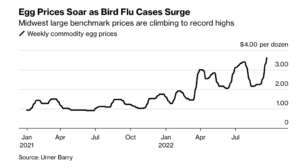The USDA is projecting that the ag trade deficit will shrink in FY2026 even more than previously anticipated. USDA expects the trade deficit to fall from $43.7 billion in FY2025…
218 Ships Have Left Ukraine Under Black Sea Export Deal, While U.S. Thanksgiving Turkey Prices in Focus
Reuters writer Pavel Polityuk reported late last week that, “A total of 211 ships with 4.7 million tonnes of agricultural products on board have left Ukraine so far under a deal brokered by the United Nations and Turkey to unblock Ukrainian sea ports, the Ukrainian infrastructure ministry said on Saturday.”
And yesterday, Reuters writer Max Hunder reported that, “Seven more ships laden with agricultural produce left Ukrainian ports on Sunday, the country’s infrastructure ministry said, bringing the total to 218 since a U.N.-brokered corridor through the Black Sea came into force at the start of August.”
Hunder noted that, “In a post on Facebook, the ministry said this brought the total amount of agricultural produce shipped through the corridor to 4.85 million tonnes.
“‘On September 25 … 7 ships with 146.2 thousand tons of agricultural produce for countries in Africa, Asia and Europe left the ports of Odesa, Chornomorsk and Pivdennyi,’ the ministry said.
“Ukraine shipped up to 6 million tonnes of grain per month before the war.”
In a separate Reuters article late last week, Pavel Polityuk reported that, “Ukraine’s 2022 grain harvest could total between 54.1 to 55.7 million tonnes compared with a record 86 million tonnes due to the Russian invasion which has reduced the harvested area, analyst APK-Inform said on Saturday.”
Meanwhile, Reuters writer David Ljunggren reported last week that, “Russia will maintain contact with the United Nations about a deal to export grain from Ukrainian ports, but says concrete results are needed, Tass news agency cited a senior official as saying on Friday.
“It also cited Deputy Foreign Minister Sergei Vershinin as saying Russia had a positive assessment of the U.N.’s efforts to resume the export of Russian fertilizers.”
More broadly, Reuters writer Ana Mano reported on Friday that, “South American soybean production will hit a record high in the season that is now being planted, agribusiness consultancy Datagro said on Friday, citing an expected area expansion to an all-time high.
“South American farmers will reap an estimated 219.34 million tonnes in the 2022/2023 season from a planted area of 66.09 million hectares (163.3 million acres), according to Datagro’s first estimate for the new crop.”
Ian Austen indicated on Saturday at The New York Times Online that, “Forecasters anticipate near-record harvests for wheat and other crops from Canadian farmers this year. It is a remarkable reversal from 2021, the season of scorching temperatures and parching drought that devastated farms throughout Western Canada.”
Austen noted that, “Statistics Canada is projecting that the harvests of wheat, canola, barley, oats, soybeans and corn will all be up this year, many of them by double-digit percentages, because of milder weather. The wheat crop, a mainstay of Canada’s farm exports, is expected to increase by 55.6 percent from last year, to 34.7 million metric tons. If that forecast proves correct, it will be one of the top three harvests on record going back to 1908.”
In more specific developments in the U.S., Reuters writer David Shepardson reported late last week that, “The U.S. Energy Department on Friday issued a plan detailing a government-wide strategy for ramping up production and use of sustainable aviation fuels (SAF).
“In September 2021, the Biden administration launched a government challenge to supply at least 3 billion gallons of SAF per year by 2030 and have enough SAF by 2050 ‘to meet 100% of aviation fuel demand, currently projected to be around 35 billion gallons a year.’ U.S. airlines have pledged to work with the government to make 3 billion gallons of SAF available to aircraft operators by 2030.”
And Bloomberg writers Diego Lasarte, Elizabeth Elkin, and Michael Hirtzer reported on Friday that,
Turkeys are selling for record high prices ahead of the Thanksgiving holiday as a resurgence of bird flu wipes out supplies across the US.
“Avian influenza is devastating egg and turkey operations in the heartland of the country. If just one bird gets it, the entire flock is culled in order to stop the spread. Millions of hens and turkeys have been killed in recent weeks. As a result, prices for turkey hens are nearly 30% higher than a year ago and 80% above pre-pandemic costs.

“Just as concerning are inventories of whole turkeys, which are the lowest going into the US winter holiday season since 2006. That means there will be little relief from inflation for Thanksgiving dinner.”
The Bloomberg writers added that, “Turkey hens are $1.82 a pound this week, according to Urner Barry, compared to $1.42 last year and $1.01 before the pandemic. Meanwhile, wholesale egg prices are at $3.62 a dozen as of Wednesday, the highest ever, up from a previous record of $3.45 a dozen set earlier this year, said John Brunnquell, chief executive officer of Egg Innovations, one of the biggest US producers of free-range eggs.

“Consumers have seen prices for eggs at grocery stores triple this year, while turkey meat rose a record-setting 60%, according to a Cobank report.”





